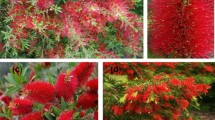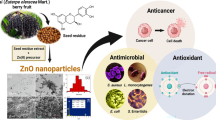Abstract
Plants have always been eminent source of medicinal products. Screening of the aqueous seeds extract of Callistemon lanceolatus (bottle brush) revealed its broad spectrum antimicrobial potential with an inhibition zone ranging from 13 to 28 mm against various pathogenic microorganisms. While optimizing the different parameters the antimicrobial activity was better expressed at 15 % concentration, prepared by extracting the material at 60 °C for 20 min. The extract was filtered through muslin cloth and gave best results at its natural pH. Statistical optimization by Response surface methodology enhanced the antimicrobial activity up to 1.6-fold. Minimum inhibitory concentration values of the aqueous extract of seeds of C. lanceolatus against different organisms ranged from 1–5 mg/ml. The viable cell count studies indicated a bactericidal effect against most of the pathogens. The aqueous extract was found to be relatively thermostable at 100 °C. When treated for shelf life at ambient conditions and refrigeration temperature (2–8 °C), the latter only showed a 28 % loss in antimicrobial activity. The aqueous extract was found to be biosafe when evaluated by 3-(4,5-dimethylthiazol-2-yl)-2,5-diphenyl tetrazolium bromide reagent (MTT toxicity) assay and Ames mutagenicity assay.








Similar content being viewed by others
References
Gould, I. M. (2008). The epidemiology of antibiotic resistance. International Journal of Antimicrobial Agents, 32, S2–S9.
Obagwu, J., & Korsten, L. (2003). Control of citrus green and blue molds with garlic extracts. European Journal of Plant Pathology, 109(3), 221–225.
Kim, J. H., Kim, J. E., Bu, H. J., & Lee, N. H. (2012). A new dioleate compound from Callistemon lanceolatus. Bulletin of Korean Chemistry Society, 33(1), 344–346.
Singh, S. (2014). Genus Callistemon: an update review. World Journal of Pharmacy and Pharmaceutical Sciences, 3(7), 291–307.
Wheeler, G. S. (2005). Maintenance of a narrow host range by Oxypos vitiosa: a biological control agent of Melaleuca. Biochemical Systematics and Ecology, 33, 365–383.
Burchett, M., Mousine, R., & Tarran, J. (2002). Phytomonitoring for urban environmental management. In Air Pollution and Plant Biotechnology (pp. 61–91). Springer Japan.
Seyydnejad, S. M., Niknejad, M., Darabpoor, I., & Motamedi, H. (2010). Antibacterial activity of hydroalcoholic extract of Callistemon citrinus and Albizia lebbeck. American Journal of Applied Sciences, 7(1), 13.
Jazet, P. M., Tatsadjieu, L. N., Ndongson, B. D., Kuate, J., Amvam, Z. P. H., & Menut, C. (2009). Correlation between chemical composition and antifungal properties of essential oils of Callistemon rigidus and Callistemon citrinus of Cameroon against Phaeoramularia angolensis. Journal of Medicinal Plants Research, 3(1), 9–15.
Zayad, N., & Aly, H. F. (2012). Induced changes in the fatty acid profile of Biomphalaria alexandrina molluscan host to Shistosoma mansoni using two sublethal concentrations of selected plant molluscicides. Journal of Applied Science Research, 8(7), 3103–3111.
Kim, J. H., Byun, J. C., Bandi, A. K. R., Hyun, C. G., & Lee, N. H. (2009). Compounds with elastase inhibition and free radical scavenging activities from Callistemon lanceolatus. Journal of Medicinal Plant Research, 3(11), 914–920.
Shukla, R., Singh, P., Prakash, B., & Dubey, N. K. (2012). Antifungal, aflatoxin inhibition and antioxidant activity of Callistemon lanceolatus (Sm.) Sweet essential oil and its major component 1, 8-cineole against fungal isolates from chickpea seeds. Food Control, 25(1), 27–33.
Jain, A. K., Dubey, S. K., Sikarwar, M. S., & Jain, S. K. (2007). Hepatoprotective activity of methanolic extract of leaves of Callistemon lanceolatus. International Journal of Plant Science, 2(2), 185–186.
Chistokhodova, N., Nguyen, C., Calvino, T., Kachirskaia, I., Cunningham, G., & Miles, D. H. (2002). Antithrombin activity of medicinal plants from central Florida. Journal of Ethnopharmacology, 81(2), 277–280.
Kumar, S., Kumar, V., & Prakash, O. M. (2011). Pharmacological evaluation of fractioned extract of Callistemon lanceolatus for antidiabetic and hypolipidemic activities in diabetic rats. Journal of Pharmacy and Allied Health Sciences, 1(2), 58–63.
Firoz, M., Bharatesh, K., Nilesh, P., Vijay, G., Tabassum, S., & Nilofar, N. (2011). Cardioprotective activity of ethanolic extract of Callistemon lanceolatus leaves on doxorubicin-induced cardiomyopathy in rats. Bangladesh Journal of Pharmacology, 6(1), 38–45.
Singh, S., & Shiva. (2013). In vitro anthelmintic activity of stem bark and seed capsules of Callistemon lanceolatus (Sm.) sweet. Der Pharmacia Sinica, 4(4), 97–102.
Sood, H., Kaur, H., & Arora, D. S. (2015). Statistical optimization of physiochemical parameters for enhancing the antimicrobial potential of lodhra (Symplocos racemosa) bark and its biosafety evaluation. International Journal of Pharmacy, 5(3), 852–866.
Arora, D. S., & Onsare, J. G. (2014). In vitro antimicrobial evaluation and phytoconstituents of Moringa oleifera pod husks. Industrial Crops and Products, 52, 125–135.
Katapodis, P., Christakopoulou, V., Kekos, D., & Christakopoulos, P. (2007). Optimization of xylanase production by Chaetomium thermophilum in wheat straw using response surface methodology. Biochemical Engineering Journal, 35(2), 136–141.
Kaur, H., Arora, D. S., & Sharma, V. (2014). Isolation, Purification, and Characterization of Antimicrobial Compound 6-[1,2-dimethyl-6-(2-methyl-allyloxy)-hexyl]-3-(2-methoxy-phenyl)-chromen-4-one from Penicillium sp. HT-28. Applied Biochemistry and Biotechnology, 173(8), 1963–1976.
Mortelmans, K., & Zeiger, E. (2000). The Ames Salmonella/microsome mutagenicity assay. Mutation Research/Fundamental and Molecular Mechanisms of Mutagenesis, 455(1), 29–60.
Ciapetti, G., Cenni, E., Pratelli, L., & Pizzoferrato, A. (1993). In vitro evaluation of cell/biomaterial interaction by MTT assay. Biomaterials, 14(5), 359–364.
Salyers, A. A., & Whitt, D. D. (2002). Bacterial pathogenesis: a molecular approach (2nd ed.). Washington, D.C.: American Society for Microbiology. Press. ISBN 1-55581-171-X.
Paluri, V., Ravichandran, S., Kumar, G., Karthik, L., & Rao, K. B. (2012). Phytochemical composition and in vitro antimicrobial activity of methanolic extract of Callistemon lanceolatus DC. International Journal of Pharmacy and Pharmaceutical Sciences, 4(2), 699–2.
Arora, D. S., Kaur, H., Onsare, J. G., & Sharma, V. (2010). Production, optimization and characterization of antimicrobial compound from Aspergillus sp. International Journal of Pharmacy, 4(1), 157–171.
Kaur, G. J., & Arora, D. S. (2009). Antibacterial and phytochemical screening of Anethum graveolens, Foeniculum vulgare and Trachyspermum ammi. BMC Complementary and Alternative Medicine, 9(1), 30.
Jalal, T. K., Ahmed, I. A., Mikail, M., Momand, L., Draman, S., Isa, M. L. M., & Wahab, R. A. (2015). Evaluation of antioxidant, total phenol and flavonoid content and antimicrobial activities of Artocarpus altilis (breadfruit) of underutilized tropical fruit extracts. Applied Biochemistry and Biotechnology, 175(7), 3231–3243.
Arora, D. S., & Chandra, P. (2011). Antioxidant activity of Aspergillus fumigatus. ISRN Pharmacology. doi:10.5402/2011/619395.
Acknowledgments
The authors are thankful to university grants commission for the grant in the form of UPE (University Potential for excellence) and the corresponding author as PI of the project. Lovedeep Nim is also thankful to UGC for Rajiv Gandhi National Fellowship for SC students (201516-RGNF-17-SC-HAR-27244).
Author information
Authors and Affiliations
Corresponding author
Ethics declarations
Conflict of Interest
The authors declare that they have no conflicts of interest.
Rights and permissions
About this article
Cite this article
Arora, D.S., Nim, L. & Kaur, H. Antimicrobial Potential of Callistemon lanceolatus Seed Extract and its Statistical Optimization. Appl Biochem Biotechnol 180, 289–305 (2016). https://doi.org/10.1007/s12010-016-2099-3
Received:
Accepted:
Published:
Issue Date:
DOI: https://doi.org/10.1007/s12010-016-2099-3




